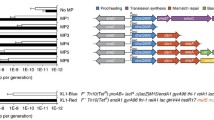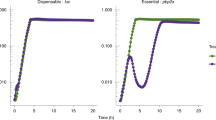Abstract
Mutator enzymes alter the nucleotide sequences of DNA or RNA molecules; immune systems utilize them to destroy the integrity of pathogen genomes and to optimize immune mediators of the host. Their dysregulation has been linked to tumorigenesis in various tissues. Defining and comparing the activities of such mutator enzymes requires a robust versatile assay that is independent of their biological context as in vivo mutation rates are typically low. Here we provide detailed protocols for two widely used E. coli-based approaches that detect the activities of ectopically expressed cytidine deaminases on two distinct reporter genes: an extrachromosomal kanamycin-resistance gene or an endogenous chromosomal substrate, the rpoB gene-encoding RNA polymerase. The generation of mutations is in both cases measured in a colony formation assay. With appropriate modifications, these assays can be extended to study other mutator enzymes.
Access this chapter
Tax calculation will be finalised at checkout
Purchases are for personal use only
Similar content being viewed by others
References
Moris A, Murray S, Cardinaud S (2014) AID and APOBECs span the gap between innate and adaptive immunity. Front Microbiol 5:534
Harris RS, Dudley JP (2015) APOBECs and virus restriction. Virology 479–480:131–145
Revy P, Muto T, Levy Y et al (2000) Activation-induced cytidine deaminase (AID) deficiency causes the autosomal recessive form of the hyper-IgM syndrome (HIGM2). Cell 102:565–575
Muramatsu M, Kinoshita K, Fagarasan S et al (2000) Class switch recombination and hypermutation require activation-induced cytidine deaminase (AID), a potential RNA editing enzyme. Cell 102:553–563
Rebhandl S, Huemer M, Greil R et al (2015) AID/APOBEC deaminases and cancer. Oncoscience 2:320–333
Conticello SG (2008) The AID/APOBEC family of nucleic acid mutators. Genome Biol 9:229
Ramiro AR, Stavropoulos P, Jankovic M et al (2003) Transcription enhances AID-mediated cytidine deamination by exposing single-stranded DNA on the nontemplate strand. Nat Immunol 4:452–456
Severi F, Chicca A, Conticello SG (2011) Analysis of reptilian APOBEC1 suggests that RNA editing may not be its ancestral function. Mol Biol Evol 28:1125–1129
Calvori C, Frontali L, Leoni L et al (1965) Effect of rifamycin on protein synthesis. Nature 207(995):417–418. https://doi.org/10.1038/207417a0
Feklistov A, Mekler V, Jiang Q et al (2008) Rifamycins do not function by allosteric modulation of binding of Mg 2+ to the RNA polymerase active center. Proc Natl Acad Sci U S A 105:14820–14825
Harris RS, Petersen-Mahrt SK, Neuberger MS (2002) RNA editing enzyme APOBEC1 and some of its homologs can act as DNA mutators. Mol Cell 10:1247–1253
Lutsenko E, Bhagwat AS (1999) The role of the Escherichia coli mug protein in the removal of uracil and 3,N4-ethenocytosine from DNA. J Biol Chem 274:31034–31038
Liu M-C, Liao W-Y, Buckley KM et al (2018) AID/APOBEC-like cytidine deaminases are ancient innate immune mediators in invertebrates. Nat Commun 9:1948
Author information
Authors and Affiliations
Corresponding author
Editor information
Editors and Affiliations
Rights and permissions
Copyright information
© 2022 Springer Science+Business Media, LLC, part of Springer Nature
About this protocol
Cite this protocol
Liu, MC., Fugmann, S.D. (2022). Measuring Mutator Enzyme Activity Using an E. coli-Based Colony Formation Assay. In: Rast, J., Buckley, K. (eds) Immune Receptors. Methods in Molecular Biology, vol 2421. Humana, New York, NY. https://doi.org/10.1007/978-1-0716-1944-5_7
Download citation
DOI: https://doi.org/10.1007/978-1-0716-1944-5_7
Published:
Publisher Name: Humana, New York, NY
Print ISBN: 978-1-0716-1943-8
Online ISBN: 978-1-0716-1944-5
eBook Packages: Springer Protocols




